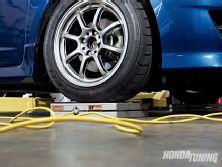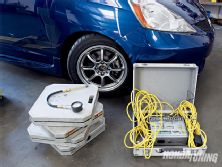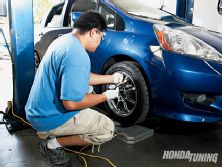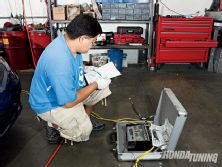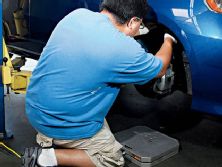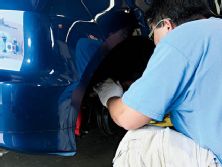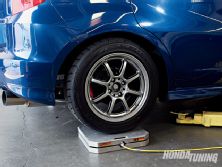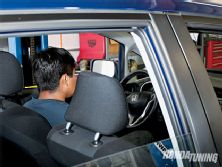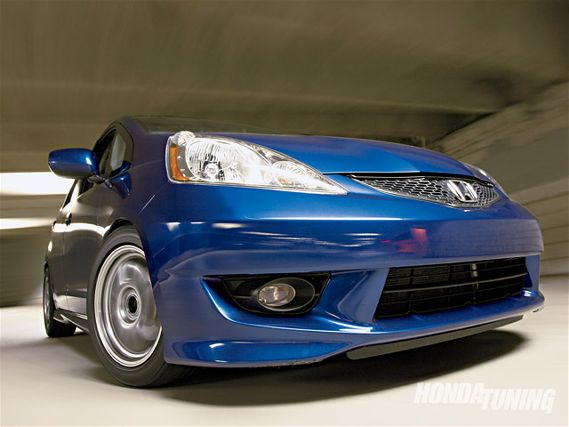 | 2009 Honda Fit - Wrenchin'
| 2009 Honda Fit - Wrenchin'
Project Fit
In the previous installments of Project Fit, we installed a set of Function Form coilovers along with a set of slightly smaller 15-inch wheels and tires. Though the car handled better after the stiffer suspension and lower center of gravity, we scoured the web for any possible upgrades in the suspension department for our little '09. As with most new cars, the aftermarket isn't exactly beating down our door with options. One idea that came to mind was a corner balancing session. For those that are new to the term, corner balancing is a sometimes lengthy process that involves adjusting the weight carried by each wheel in an attempt to find improved balance. A proper balance will often give a car the ability to handle much better; one of our main goals for the project. Let's face it: short of swapping out the motor, this car is not going to be a screamer. Why not focus on something that all cars can benefit from; superior handling.
Most Honda builders look toward lowering the car as the single most important aspect of a build. Not only is it important in changing a car's handling characteristics, but also because it eliminates that unsightly 4x4 stance. We all know that dropping your Civic to the ground isn't the smartest move, especially if you want to avoid doing twelve point turns in your neighborhood. This is nothing new as it's been pounded into our heads for years. One aspect we seem to overlook when it comes to the suspension puzzle is a good balance. Analyzing a vehicle in diagonal terms (right front wheel, left rear wheel for example), if one wheel is carrying too much weight, the handling will in fact suffer. Imagine if your car had three stiff spring rates, and one OEM spring, you'd realize the imbalance almost immediately. You'll probably never run into anything that extreme, but diagonal imbalances are common, and can be corrected through spring height adjustments and corner balancing. You might be asking yourself, "why not just relocate the battery or move something else around until you find a better balance?" That might help, but it would never equal the precision you'll find from weight distribution via spring height changes. Keep in mind, if there's too much weight in one corner, there's also too much weight in the opposite corner. For example, if you lower the left rear corner of the car, that wheel, along with the right front corner (think diagonally) will then rely on the other two wheels to carry more of the car's weight. You haven't taken weight away from the car; you've simply transferred some of it to the other wheels.
I did have some reserves about attempting to corner balance the Fit as I assumed only hardcore track cars with high dollar suspension set-ups would benefit from the process. Beyond that, I had no idea how much the whole thing would cost, and didn't want to commit to something that was out of the budget for the average tuner. However, after speaking to Loi Song of Sportcar Motion in San Marcos, CA, my theory was quickly shot down. Loi states "corner balancing is one of the most important factors of proper handling. It really doesn't matter if it's a street car, or a track car. You can take any car with adjustable coilovers and improve on it by just taking the time to get your weight distribution corrected." After being assured that the process wouldn't cost an arm and a leg, I set out to pay a visit to Sportcar Motion, and kept my fingers crossed in hopes that the changes would pay off. With a few front-wheel drive Honda records under their belt, I was confident they'd pull something out of our car.
The Road Test
Once Loi and his crew finished the corner balance process, tire pressure and lug nuts were double checked, and I was on my way out of the shop. Just a few miles from Sportcar Motion lies a twisty two lane stretch of pavement peppered with tight back-to-back turns. We took the Fit for a quick sprint to compare the before and after. Upon the first turn, the results were painfully obvious. This was exactly what we were missing after lowering the car. It felt more nimble from the very moment the little four-door was pushed hard. The increased feeling of grip and overall silky transitions meant higher entry speeds and smoother exits. The "dive" that the Fit seemed to exhibit when entering a turn has been scaled back tremendously. Because we were still on a public road, we didn't get too gutsy, as the street is not the place to take chances. But before getting a weekend track day with the Fit, there are a couple of items that would make the day a bit more interesting; rear disc brakes and a driver side bucket seat. The seating position is far too high, and under harsh driving conditions, seems to sap driver confidence. There are plenty of aftermarket bucket seats we could opt for, though seat brackets and sliders may not be an option for the 2009 model.
The Numbers
Sportcar Motion recommended a 60 front, 40 rear weight distribution for our car. After bringing the car up slightly, we managed to reach a 63.2 front, and 36.8 rear weight distribution.
The difference in handling was a slap in the face. Corner balancing is exactly what the Fit needed, and there's no question it will be our first stop after installing coilovers on our next project. The process took approximately 90minutes, with a price tag just over $200. One of the best upgrades we've done so far, and it didn't wreak havoc on our bank account.

